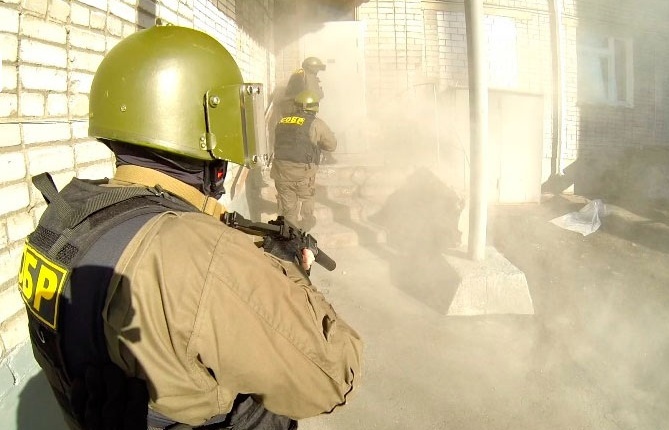
Death of Tatar Militant Unlikely to End Streak of Militancy in the Volga
Publication: Eurasia Daily Monitor Volume: 11 Issue: 87
By:

On September 24, 2006, almost immediately after Doku Umarov was appointed president of Ichkeria, he started reviewing the structure of the armed jihadi insurgency in Russia. Umarov merged his few jihadi subordinates in the Volga and the Ural regions with the North Caucasian militancy, establishing new fronts—the Volga and Ural fronts—which were subordinated to him directly (https://www.kommersant.ru/doc/709250).
The selection of these areas was not arbitrary, given that both have Tatar minorities. Having established an illusory joint command with the Tatars, Umarov did not simply expand the territory of the insurgency, but united various ethnic groups on the basis of Islam. Thus, in September 2007, Ichkeria was transformed into the Caucasus Emirate. It was apparently Shamil Basaev who launched the creation of the jamaats in Tatarstan at the beginning of the second Russian-Chechen war in 1999. Basaev believed the Tatar jamaats would tie up Russia’s resources, deflecting it from the North Caucasus (https://www.kazan-center.ru/osnovnye-razdely/14/163/). The jihadists of the Volga and Ural regions, formally or not, agreed to their merger with the North Caucasian armed resistance.
Therefore, it was strange that there was so little reaction in Russia to the news about the killing of the leader of Tatar jihadists, Emir Mohammad (Rais Mingaleyev), in a special operation conducted by Federal Security Service (FSB) officers in Chistopol, Tatarstan, on the night of April 30. The city is located 134 kilometers from Tatarstan’s capital of Kazan and is the center of Chistopol district. The Russian security services had received information about armed terrorists located in a desolate area of parking garages several days before the operation (https://www.interfax-russia.ru/Povoljie/view.asp?id=496834).
The special operation was announced the morning of May 1. According to the Russian security services, the militants rejected an offer to surrender and started shooting. One of the militants attempted to escape through a secret passage and hurled a grenade at the servicemen, but was killed. The second militant, who remained in the garage, blew himself up. Two servicemen were wounded in the operation. Police found a Makarov pistol with a spare magazine, an F-1 hand grenade, several improvised explosive devices (IED) and other ammunition at the scene (https://continentalist.ru/2014/05/na-likvidatsiyu-glavyi-terroristov-i-druga-umarova-v-tatarstane-na-ocheredi-drug-yarosh/).
The slain suspects were identified as 38-year-old Rais Mingaleyev and 35-year-old Beslan Nazipov. According to government agencies, these individuals were the organizers of and participants in various terrorist crimes, including the attempt to assassinate the mufti of the Spiritual Board of Muslims of Tatarstan, Ildus Faizov, in July 2012, the murder of the chief of the board’s educational department, Valiulla Yakupov, as well as other attacks (https://news.mail.ru/inregions/volgaregion/16/incident/18048047/). The Investigative Committee reported that two officers were injured trying to arrest the criminals (https://www.rosbalt.ru/federal/2014/05/01/1263783.html).
According to Russia’s National Antiterrorist Committee, Mingaleyev was the leader of the Tatar militants and had ties to the armed underground movement in the North Caucasus (https://news.mail.ru/inregions/volgaregion/16/incident/18048714/?frommail=1). Tatarstan’s jamaat has apparently struggled to break through the FSB’s defenses. On November 16, 2013, unidentified people fired four improvised projectiles at the Nizhnekamskneftekhim chemical factory in the city of Nizhnekamsk. One of the projectiles landed in a prison and the three others flew for 800 meters (https://www.rosbalt.ru/federal/2013/11/18/1200679.html). Tatarstan’s jamaat was also accused of arson attacks on five churches in the republic, although the perpetrators were not necessarily members of the jihadist movement (https://interfax-russia.ru/Povoljie/view.asp?id=456081).
The murder of Rais Mingaleyev is unlikely to change anything in Tatarstan. The leadership of the jihadists is nominal and is usually needed only to unite various groups on a given territory. No direct vertical line of command appears to exist, which preserves the jamaat from heavy losses in the event the leader is killed.
It should be noted that the Russian security services had already reported a successful special operation against the perpetrators of the attempt on the Tatarstan mufti’s life. Back in October 2012, two people named Kashapov and Valeyev were killed in Kazan, and they may have been members of Mingaleyev’s jamaat (https://www.ntv.ru/novosti/358640/). The example of the North Caucasus suggests that the list of slain suspected militants supposedly implicated in the attempt on the life of the mufti will grow over time.
Tatarstan is receiving special attention from the Russian security services. The republic is far more valuable and dangerous to Russia than Chechnya was in the 1990s. It is a more diverse place in its beliefs than Chechnya. Not only Salafists exist there, but also members of the Muslim Brotherhood, Hizb ut-Tahrir, Takfir wal-Hijra and Tablighi Jamaat. All of these, combined with Tatar nationalism and separatism, make the situation in Tatarstan more complex than in the North Caucasus, where the confrontation is a clear-cut one between Salafism and “moderate Islam”—the latter representing the interests of the Russian authorities.
In the first quarter of 2014, the FSB killed 13 leaders and 65 active members of the armed underground movement, while 240 members of the movement were arrested, and 250 kilograms of explosives, 79 IEDs and 500 weapons were confiscated. The FSB also prevented nine terrorist attacks (https://3mv.ru/publ/fsb_s_nachala_goda_v_rossii_predotvrashheno_19_teraktov/1-1-0-24703). This data covers not only the North Caucasus, but all of Russia, which means that cells of the Caucasus Emirate are likely to appear anywhere in the country.
Multiple Tatar radical groups are likely to spread further in the Volga region and the Urals since officials in Moscow have no chance of changing the mindset of the Tatars. Against the background of multiple special operations in the North Caucasus, Tatarstan could become a potential successor to the North Caucasus in terms of future violence and instability. This possibility is amplified by Russia’s recent acquisition of Crimea, where Crimean Tatars are likely to become another headache for Russian authorities given the history of their nationalism and the presence of a charismatic leader like Mustafa Cemilev. One should not dismiss the idea that a Tatar front might one day emerge from Crimea to Siberia, which could become the zone of a new and severe confrontation between Russia and radical Islam in the near future.




